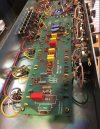LoudStroud
Well-Known Member
- Joined
- Sep 22, 2020
- Messages
- 346
- Reaction score
- 700
Very interesting information in the above comments that I was not aware of before. I have a 79 JMP 2204 that is a total keeper. Just recently considered picking up an 81 JCM800 2203 and was researching any differences to the earlier late 70s JMP‘s. The only difference I was finding were the capacitors… My 79 has beige colored caps where the 81 had the red caps. Assuming two different manufacturers that could have a minor effect on the tone. other than that, they appeared the same.
Was not aware that the JCM 2204 possibly had a higher B+ voltage, which could make it a little tighter on the low end, part of which likely contributed to the amp being so popular during the early 80s hair metal days. Now has my curiosity reignited about picking up an early JCM!
Other than that, it appeared the 79 JMP and the 81 - 83 JCM were essentially the same inside. After 83, I recollect, is when they began the horizontal inputs and mounting the pots directly to the circuit board. I believe I read that the filtering reduced as well on the 2203s. Maybe also the transformers changed?
Was not aware that the JCM 2204 possibly had a higher B+ voltage, which could make it a little tighter on the low end, part of which likely contributed to the amp being so popular during the early 80s hair metal days. Now has my curiosity reignited about picking up an early JCM!
Other than that, it appeared the 79 JMP and the 81 - 83 JCM were essentially the same inside. After 83, I recollect, is when they began the horizontal inputs and mounting the pots directly to the circuit board. I believe I read that the filtering reduced as well on the 2203s. Maybe also the transformers changed?




